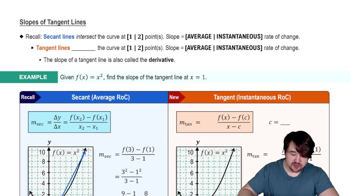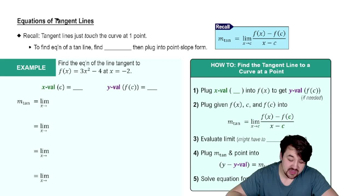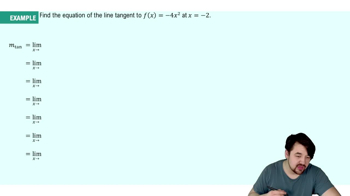Table of contents
- 0. Functions7h 52m
- Introduction to Functions16m
- Piecewise Functions10m
- Properties of Functions9m
- Common Functions1h 8m
- Transformations5m
- Combining Functions27m
- Exponent rules32m
- Exponential Functions28m
- Logarithmic Functions24m
- Properties of Logarithms34m
- Exponential & Logarithmic Equations35m
- Introduction to Trigonometric Functions38m
- Graphs of Trigonometric Functions44m
- Trigonometric Identities47m
- Inverse Trigonometric Functions48m
- 1. Limits and Continuity2h 2m
- 2. Intro to Derivatives1h 33m
- 3. Techniques of Differentiation3h 18m
- 4. Applications of Derivatives2h 38m
- 5. Graphical Applications of Derivatives6h 2m
- 6. Derivatives of Inverse, Exponential, & Logarithmic Functions2h 37m
- 7. Antiderivatives & Indefinite Integrals1h 26m
- 8. Definite Integrals3h 25m
2. Intro to Derivatives
Tangent Lines and Derivatives
Problem 3.R.99a
Textbook Question
The population of the United States (in millions) by decade is given in the table, where t is the number of years after 1910. These data are plotted and fitted with a smooth curve y = p(t) in the figure. <IMAGE><IMAGE>
Compute the average rate of population growth from 1950 to 1960.
 Verified step by step guidance
Verified step by step guidance1
Identify the values of t corresponding to the years 1950 and 1960. Since t is the number of years after 1910, for 1950, t = 40 and for 1960, t = 50.
Determine the population values p(40) and p(50) from the provided data or the fitted curve y = p(t).
Use the formula for the average rate of change, which is given by the expression: \( \text{Average Rate} = \frac{p(50) - p(40)}{50 - 40} \).
Substitute the values of p(40) and p(50) into the average rate of change formula to find the average rate of population growth.
Interpret the result in the context of the problem, understanding that the average rate of population growth represents the change in population per decade.
Recommended similar problem, with video answer:
 Verified Solution
Verified SolutionThis video solution was recommended by our tutors as helpful for the problem above
Video duration:
3mPlay a video:
Was this helpful?

 5:13m
5:13mWatch next
Master Slopes of Tangent Lines with a bite sized video explanation from Nick
Start learningRelated Videos
Related Practice




